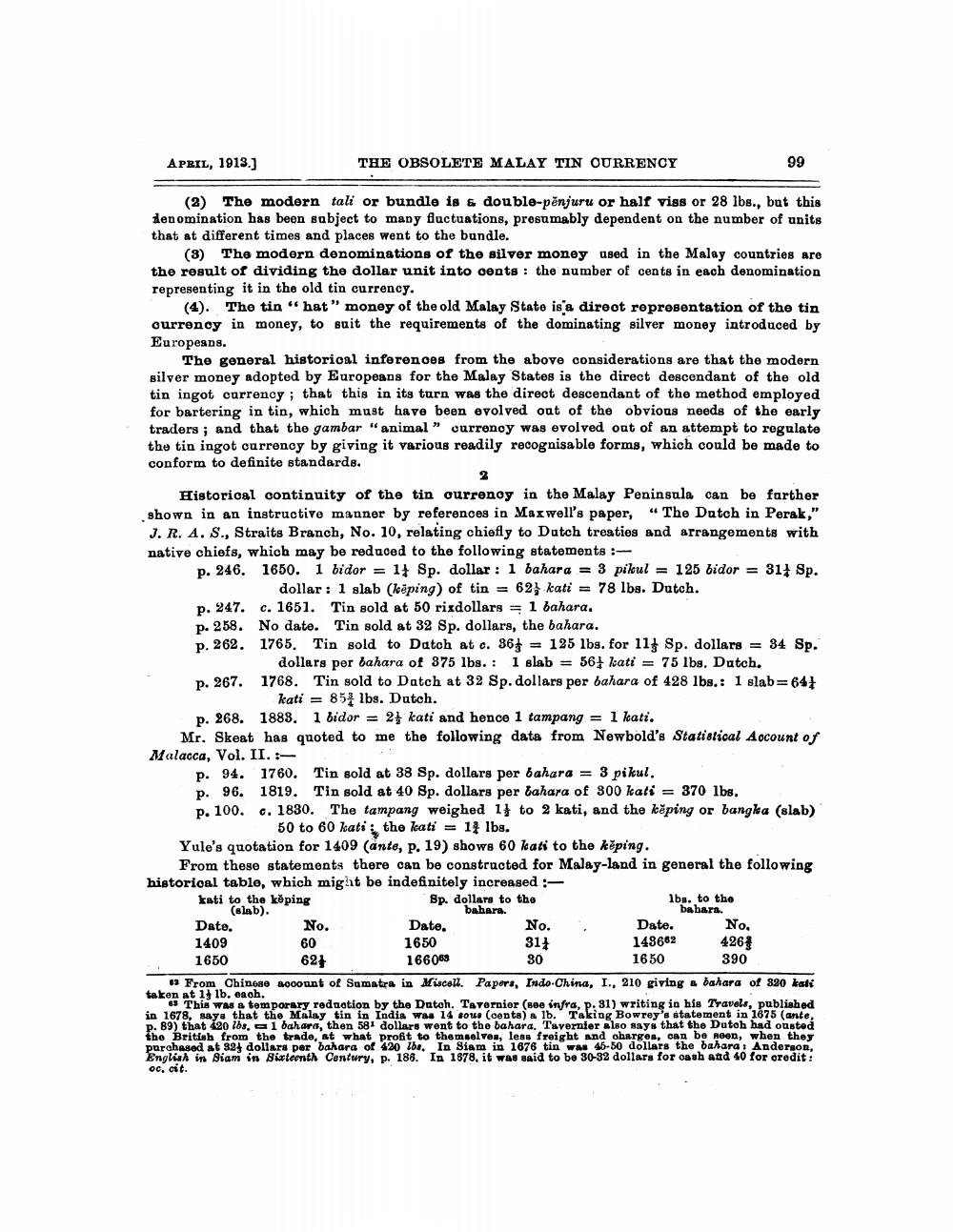________________
APRIL, 1913.)
THE OBSOLETE MALAY TIN QURRENCY
99
(2) The modern tali or bundle is & double-penjuru or half viss or 28 lbs., but this denomination has been subject to many fluctuations, presumably dependent on the number of units that at different times and places went to the bundle.
(3) The modern denominations of the silver money used in the Malay countries are the result of dividing the dollar unit into coats: the number of cents in each denomination representing it in the old tin currency.
(4). The tin "hat" money of the old Malay State is a diroot representation of the tin currency in money, to suit the requirements of the dominating silver money introduced by Europeans.
The general historical inferences from the above considerations are that the modern silver money adopted by Europeans for the Malay States is the direct descendant of the old tin ingot currency; that this in its turn was the direct descendant of the method employed for bartering in tin, which must have been evolved out of the obvious needs of the early traders, and that the gambar "animal” currenoy was evolved out of an attempt to regulate the tin ingot currency by giving it various readily recognisable forms, which could be made to conform to definite standards.
2
Historical continuity of the tin currenoy in the Malay Peninsula can be further shown in an instructive manner by references in Maxwell's paper, "The Dutch in Perak," J. R. A. S., Straits Branch, No. 10, relating chiefly to Datch treaties and arrangements with native chiefs, which may be reduced to the following statements :p. 246. 1650. 1 bidor = 14 Sp. dollar: 1 bahara = 3 pikul = 125 bidor = 314 Sp.
dollar: 1 slab (leöping) of tin = 62} kati = 78 lbs. Dutch. p. 247. c. 1651. Tin sold at 50 rixdollars = 1 bahara. p. 258. No date. Tin sold at 32 Sp. dollars, the bahara. p. 262. 1765. Tin sold to Datoh at c. 363 = 125 lbs. for 113 Sp. dollars = 34 Sp.
dollars per bahara of 375 lbs.: 1 slab = 561 kati = 75 lbs. Datch. p. 267. 1768. Tin sold to Datch at 32 Sp.dollars per bahara of 428 lbs.: 1 slab= 647
kati = 854 lbs. Dutch. p. 268. 1888, 1 bidor = 2 kati and hence 1 tampang = 1 kati.
Mr. Skeat has quoted to me the following data from Newbold's Statistical Account of Malacca, Vol. II.
D. 94. 1760. Tin sold at 38 Sp. dollars per bahara = 3 pikul. p. 96. 1819. Tin sold at 40 Sp. dollars per bahara of 300 kati = 370 lbs. p. 100. c. 1830. The tampang weighed i} to 2 kati, and the kẽping or bangka (slab)
50 to 60 kati : the kati = 14 lbs. Yule's quotation for 1409 (ante, p. 19) shows 60 kati to the kēping.
From these statements there can be constructed for Malay-land in general the following historical table, which might be indefinitely increased :kati to the keping Sp. dollars to the
lbs. to the (slab).
bahara.
babara. Date. No. Date. No.
Date. 1409 60 1650
314
148662 4269 1650 627 166063
1650 390 - From Chinese account of Sumatra in Miscell. Papers, Indo-China, I., 210 giving & bahara of 820 kati taken at 1 lb. each.
68 This was a temporary redaction by the Datoh. Tavernier (see infra, p. 31) writing in his Travels, published in 1678, says that the Malay tin in India was 14 sous (centa) a lb. Taking Bowrey's statement in 1675 (ante, p. 89) that 220 lbs, 1 bahara, then 581 dollars went to the bahara. Tavernier also says that the Dutch had oustod Eho British from the trade, at what profit to themselves, less freight and charges, can be doen, when they purchased at 894 dollars per bahara of 420 lbs. In Siam in 1676 tin was 46-50 dollars the bahara : Anderson, English in Siam in Sixteenth century, p. 186. In 1878, it was said to be 30-32 dollars for oash and 40 for credit: oc. cit.
No.
80




